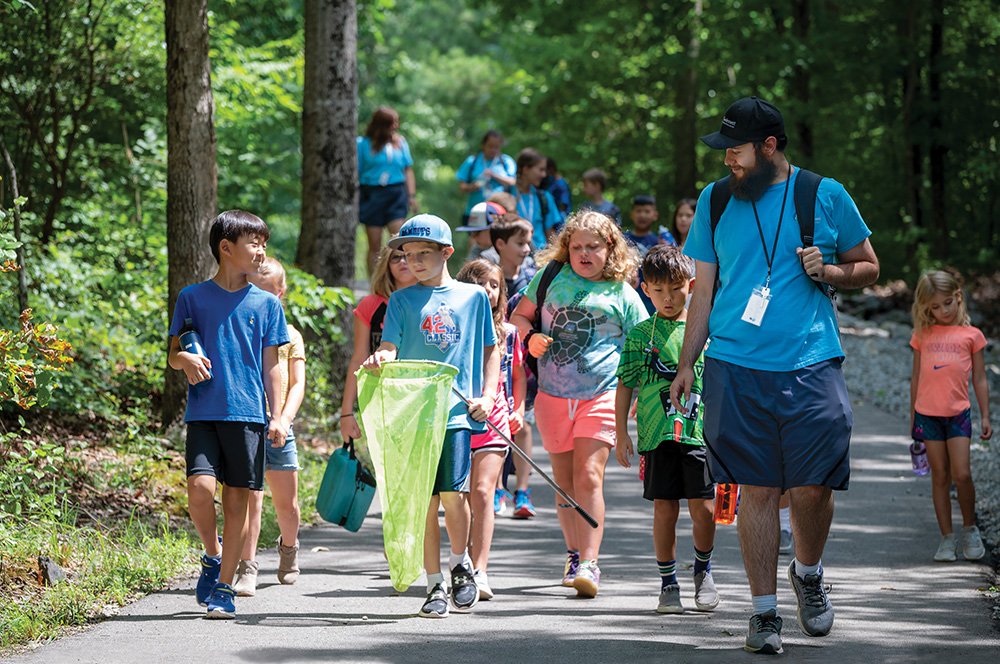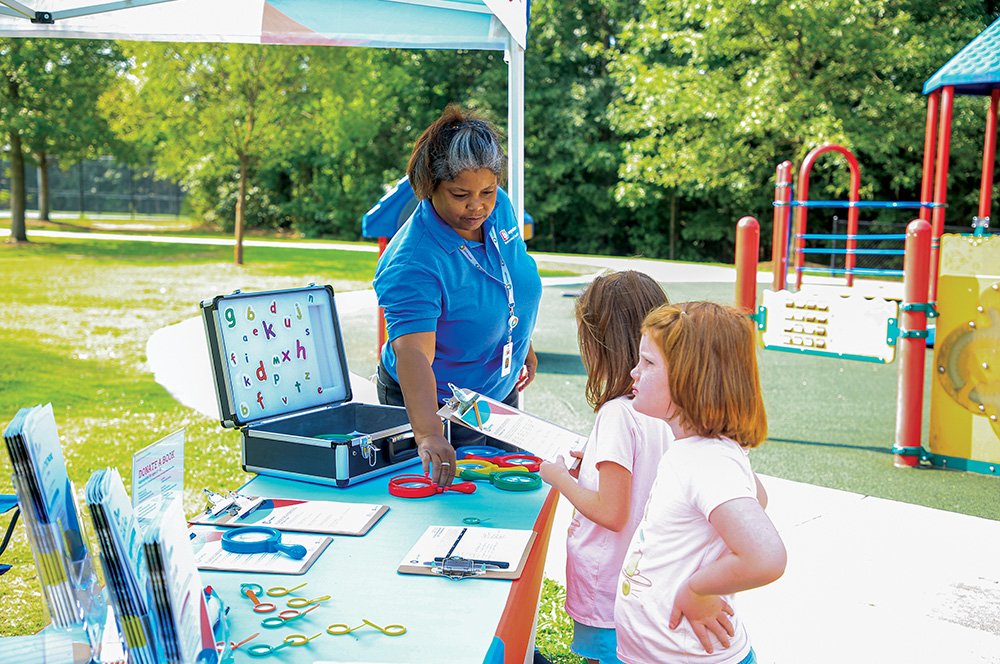Playgrounds And Parks Become Ground Zero For STEM Education
Outdoor, play-based learning supports school curriculums and unlocks new worlds for children
By Jefferey Spivey
Photos: Gwinnett County Parks & Recreation
There’s a lot to take in at Triumph Park. Spread over 66 acres in Waukee, Iowa, the community park and sports complex boasts 12 softball and baseball fields, three miles of trails, an accessible fishing pier, and an inclusive playground with dozens of play structures.
The breadth of recreational activities has attracted both locals and tourists—as of October 29, the park had received 395,000 visits from 161,000 visitors since its June 2022 opening. But for children aged 12 and under, the playground has likely been the biggest draw.
“The size and magnitude of this play structure can engage a kid for quite some time,” says Matt Jermier, Parks & Recreation Director for the city of Waukee. “For them, it’s like an amusement park.”
The playground was designed for children of varying abilities and includes traditional playground equipment as well as a variety of calming and musical elements. Also by design, many of the play structures were chosen specifically to help children explore concepts of science, technology, engineering, and math, collectively known as STEM.
For example, the Interactive Talk about Gravity Panel features two apples, which children can move along pre-cut grooves and then drop to see what happens next. Simple on its surface, the activity helps children develop their vocabulary around scientific concepts like gravity while simultaneously working on motor and social skills and engaging their visual, proprioception, tactile, and auditory sensory systems. Similarly, the I Spy Periscope Panel gives young visitors a chance to look at different pictures and describe what they’re seeing, which also expands their grasp of scientific language while activating several sensory systems and developing social, cognitive, and motor skills.
“Kids tend to gravitate toward those panels, and [it] gives them an opportunity to learn while they’re playing,” Jermier says.
Even in panels that aren’t explicitly labeled STEM structures, there’s still often a connection to STEM through sensory experiences. In fact, throughout the playground and no matter the feature, children are developing essential skills while having a blast.
But there’s more to this mix of play and education than simply keeping kids occupied for long periods of time.
Where Playgrounds, Nature, And STEM Intersect
“STEM exposure in any setting is vital for critical thinking,” says Christy Mory, Environmental Recreation Specialist for the Prince William County, Va., Department of Parks, Recreation and Tourism.
Since 2012, her department has run the Science in the Park program, which facilitates meaningful, environmental-science field trips for students in kindergarten through sixth grade. The primary objective is to use hands-on science to drive home grade-specific concepts as outlined in the Virginia Standards of Learning.
Mory says Science in the Park isn’t play-based, “but we do use the parks surrounding the playgrounds to lead students to trails, streams, and open fields for lessons.” That proximity to playgrounds underscores how play, the great outdoors, and STEM go hand in hand, even if one element only serves as a jumping-off point for another.
In the same vein, in Gwinnett County, Ga., where STEM and STEAM (science, technology, engineering, arts, and math) programs have been offered for over a decade, learning opportunities didn’t initially incorporate play. Much of what was offered took place in a more formalized setting at the Gwinnett Environmental and Heritage Center. But, in recent years, program offerings have expanded to include public parks and playgrounds.
On the 233-acre Environmental and Heritage Center campus is a treetop adventure course, which leads to a dynamic science experience for visitors.
“We looked at the physics behind the design of the course,” says Jason West, Deputy Division Director of Collaboration for the Gwinnett County Department of Community Services. More than providing ziplining and chasing adrenaline rushes, he says the course helps visitors understand concepts about moving from point A to point B.
West adds that much of Gwinnett County’s STEM programming is customized to provide memorable visits to area parks that also align with educators’ curriculum objectives.
“We work hand in hand with our local school system gathering feedback from teachers and district office staff in both the science and social studies offices, just making sure that the things that we’re touching on are the things that an educator would want to see highlighted,” he says.
In one instance, a Duluth-based middle school expressed interest in a classification ecology program but was unable to visit the Environmental and Heritage Center, and asked for an experience in a park closer to home. West’s department accepted the challenge, designing a curriculum at a nearby park that focused on stream-bank restoration, food webs, and classification.
That improvisatory approach extends to play.
“A lot of times, we’ll utilize the playground space for a program because it’s just a natural fit,” West says. Many of Gwinnett County’s parks have community gardens. Programs for early learners often start there, with students learning to count, sort, and classify different objects. They then investigate as “playground detectives” on various structures to spot specific letters or other elements.
There’s no shortage of locations to host these activities.
“We have 77 playgrounds within our park system,” says Glenn Boorman, Division Director of Project Administration for the county’s Parks & Recreation Department. While many of the playgrounds weren’t designed through a specific STEM lens, they were designed for accessibility and sensory experiences, which naturally lend themselves to STEM learning.
“A lot of the things within the playgrounds become an education for [children] without [them] knowing it,” Boorman says.
Even so, two of the county’s forthcoming projects are explicitly centered on STEM exposure and learning. One is an environmental park, currently in the design phase. The interactive space will focus on wetland restoration and features a half-mile boardwalk across local wetlands. West is currently working on programming to complement the environmentally-minded park.
The second project completely reimagines what a playground can be. Set to open on the Environmental and Heritage Center campus in about a year and a half, the multisensory, accessible treehouse will be an elevated platform with various stations focused on animal habitat, pollinators, food webs, and adaptations. To explore habitats at one station, visitors will have a chance to crawl into a replica of a squirrel drey. Another station will be a theater housed in the trunk of a large American chestnut tree, where children can experience both day and night in the forest.
The treehouse will serve as a noteworthy location for K-12 field trips. However, it will also be open to the general public, offering STEM and STEAM-focused activities.
Regardless of age, everyone will benefit. But the youngest visitors will likely have the most to gain.
STEM Goes Beyond Tech
Both West and Boorman see outdoor STEM learning as an antidote to technology obsession.
“Involvement in STEM is going to lend to things like focusing on creativity and problem-solving and collaboration with partners, and trying to identify the way something works, or developing a particular project,” West says. “There are all kinds of enhancements in a kid’s way of thinking.”
Mory echoes this sentiment in discussing Science in the Park. Students are asked to observe and question what they see, which fuels their understanding of scientific concepts and gives them a chance to build upon their newly-formed knowledge base.
West also feels that nature-based science education helps dispel the myth that STEM is only about modern tech. For example, his team uses a historic gristmill in one of Gwinnett County’s parks to demonstrate how simple machines work. He also points to some of the county’s camps at which students can play with mud or use sticks and environmental materials to build bridges.
To the untrained eye, it might look like kids are just being kids. But West sees great potential.
“You take a kid who’s used to being on a phone all day and really get them outside and play with things like mud, that’s pretty cool. And it’s going to ignite something in that kid’s mind,” he said. “We have no idea what it might lead to. But I can tell you it’s going to lead to something good.”
Jefferey Spivey is a writer based in Urbandale, Iowa. Reach him at jeffereyspivey@gmail.com.



